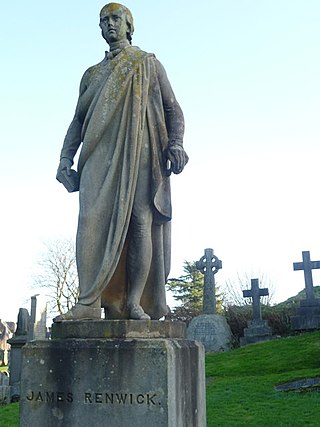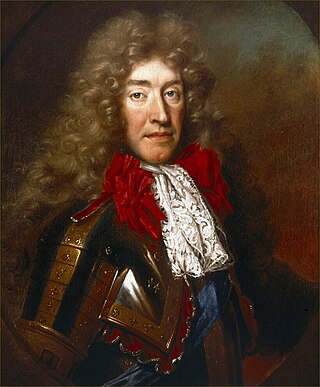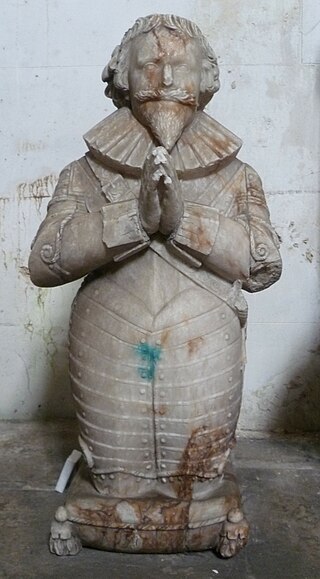
The Acts of Union refer to two Acts of Parliament, one by the Parliament of England in 1706, the other by the Parliament of Scotland in 1707. They put into effect the Treaty of Union agreed on 22 July 1706, which merged the previously separate Kingdom of England and Kingdom of Scotland into a single Kingdom of Great Britain, with Queen Anne as its sovereign. The Acts took effect on 1 May 1707, creating the Parliament of Great Britain, based in the Palace of Westminster.

John Maitland, 1st Duke of Lauderdale, KG, PC was a Scottish statesman and peer.

Alexander Henderson was a Scottish theologian, and an important ecclesiastical statesman of his period. He is considered the second founder of the Reformed Church in Scotland. He was one of the most eminent ministers of the Church of Scotland in the most important period of her history, namely, previous to the middle of the seventeenth century.

John Spottiswoode was an Archbishop of St Andrews, Primate of All Scotland, Lord Chancellor, and historian of Scotland.

The Killing Time was a period of conflict in Scottish history between the Presbyterian Covenanter movement, based largely in the southwest of the country, and the government forces of Kings Charles II and James VII. The period, roughly from 1679 to the Glorious Revolution of 1688, was subsequently called The Killing Time by Robert Wodrow in his The History of the Sufferings of the Church of Scotland from the Restoration to the Revolution, published in 1721–22. It is an important episode in the martyrology of the Church of Scotland.

The Education Act 1696 was an act of the Parliament of Scotland that ordered locally funded, church-supervised schools to be established in every parish in Scotland. It was passed by the Parliament at Edinburgh on 8 September 1696 in the reign of Mary II and William II. The Act for Settling of Schools stated that for every parish without a school and paid schoolmaster

The 1689 Convention of Estates sat between 16 March 1689 and 5 June 1689 to determine the settlement of the Scottish throne, following the deposition of James VII in the 1688 Glorious Revolution. The Convention of the Estates of Scotland was a sister-institution to Parliament, comprising the three estates of bishops, barons and representatives of the Burghs. Historically, it had been summoned by the king of Scots for the limited purpose of raising taxes, and could not pass other legislation. Unlike the English Convention Parliament of 1689, the 1689 Scottish Convention was also a contest for control of the Church of Scotland or Kirk.
The history of the Scottish Episcopal Church is traced by the church to ancient times. The Church today is a Christian denomination in Scotland and a member of the Anglican Communion. It has enjoyed a distinct identity and is neither Roman nor English. It is therefore not a Daughter Church in the Anglican communion.

The Education Act 1646 was an Act of the Parliament of Scotland that ordered locally funded, Church-supervised schools to be established in every parish in Scotland. It was passed by the Parliament at St. Andrews on 2 February 1646 in the reign of Charles I, titled "Act for founding of schools in every parish."
The School Establishment Act 1616 was an Act of the Scottish Privy Council dated 10 December 1616. It mandated the establishment of publicly funded, Church-supervised schools in every parish of Scotland. The act was a consequence of the Scottish Reformation, and was the basis of all future acts of the Parliament of Scotland related to school establishment.

Under Charles I, the Puritans became a political force as well as a religious tendency in the country. Opponents of the royal prerogative became allies of Puritan reformers, who saw the Church of England moving in a direction opposite to what they wanted, and objected to increased Catholic influence both at Court and within the Church.

Covenanters were members of a 17th-century Scottish religious and political movement, who supported a Presbyterian Church of Scotland and the primacy of its leaders in religious affairs. It originated in disputes with James VI and his son Charles I over church organisation and doctrine, but expanded into political conflict over the limits of Royal authority.

The Restoration was the return of the monarchy to Scotland in 1660 after the period of the Commonwealth, and the subsequent three decades of Scottish history until the Revolution and Convention of Estates of 1689. It was part of a wider Restoration in the British Isles that included the return of the Stuart dynasty to the thrones of England and Ireland in the person of Charles II.
Sir Robert Spottiswood, Lord Newabbey of New Abbey and Dunipace, was a Scottish lawyer, Lord President of the Court of Session and member of the Privy Council to James VI of Scotland, and Lord President of the College of Justice and Secretary for Scotland, appointed by Charles I of Scotland.
John Kennedy, 6th Earl of Cassilis, PC was a Scottish peer, the grandson of Gilbert Kennedy, 4th Earl of Cassilis, and nephew of John Kennedy, 5th Earl of Cassilis. He succeeded to the titles of 8th Lord Kennedy and 6th Earl of Cassilis on 25 July 1616. He was a non-sitting member of Cromwell's House of Lords, and was invested as a Privy Counsellor of Scotland on 13 February 1660/61. He held the office of Justice-general from 1649 to 1651 and of an Extraordinary Lord of Session for Scotland from June 1661 to July 1662.

The Glorious Revolution in Scotland refers to the Scottish element of the 1688 Glorious Revolution, in which James VII was replaced by his daughter Mary II and her husband William III as joint monarchs of Scotland, England and Ireland. Prior to 1707, Scotland and England shared a common monarch but were separate legal entities, so decisions in one did not bind the other. In both countries, the Revolution confirmed the primacy of Parliament over the Crown, while the Church of Scotland was re-established as a Presbyterian rather than Episcopalian polity.

Education in early modern Scotland includes all forms of education within the modern borders of Scotland, between the end of the Middle Ages in the late fifteenth century and the beginnings of the Enlightenment in the mid-eighteenth century. By the sixteenth century such formal educational institutions as grammar schools, petty schools and sewing schools for girls were established in Scotland, while children of the nobility often studied under private tutors. Scotland had three universities, but the curriculum was limited and Scottish scholars had to go abroad to gain second degrees. These contacts were one of the most important ways in which the new ideas of Humanism were brought into Scottish intellectual life. Humanist concern with education and Latin culminated in the Education Act 1496.

Scottish religion in the seventeenth century includes all forms of religious organisation and belief in the Kingdom of Scotland in the seventeenth century. The 16th century Reformation created a Church of Scotland, popularly known as the kirk, predominantly Calvinist in doctrine and Presbyterian in structure, to which James VI added a layer of bishops in 1584.

The history of schools in Scotland includes the development of all schools as institutions and buildings in Scotland, from the early Middle Ages to the present day. From the early Middle Ages there were bardic schools, that trained individuals in the poetic and musical arts. Monasteries served as major repositories of knowledge and education, often running schools. In the High Middle Ages, new sources of education arose including choir and grammar schools designed to train priests. Benedictine and Augustinian foundations probably had charitable almonry schools to educate young boys, who might enter the priesthood. Some abbeys opened their doors to teach the sons of gentlemen. By the end of the Middle Ages, grammar schools could be found in all the main burghs and some small towns. In rural areas there were petty or reading schools that provided an elementary education. Private tuition in the families of lords and wealthy burghers sometimes developed into "household schools". Girls of noble families were taught in nunneries and by the end of the fifteenth century Edinburgh also had schools for girls, sometimes described as "sewing schools". There is documentary evidence for about 100 schools of these different kinds before the Reformation. The growing humanist-inspired emphasis on education cumulated with the passing of the Education Act 1496.
Andrew Duncan was a Latin scholar and Church of Scotland minister at Crail. He achieved notoriety for his presbyterian principles which brought him into conflict with James VI who wished to impose an episcopalian system. He attended the General Assembly of Aberdeen in 1605 which had been proscribed or prorogued by royal authority and was one of six ministers who were imprisoned and later exiled as a result. He was allowed to return after several years in France but was subsequently banished again following further controversy in failing to comply with the Five Articles of Perth. He died in exile in Berwick-upon-Tweed in 1626.















